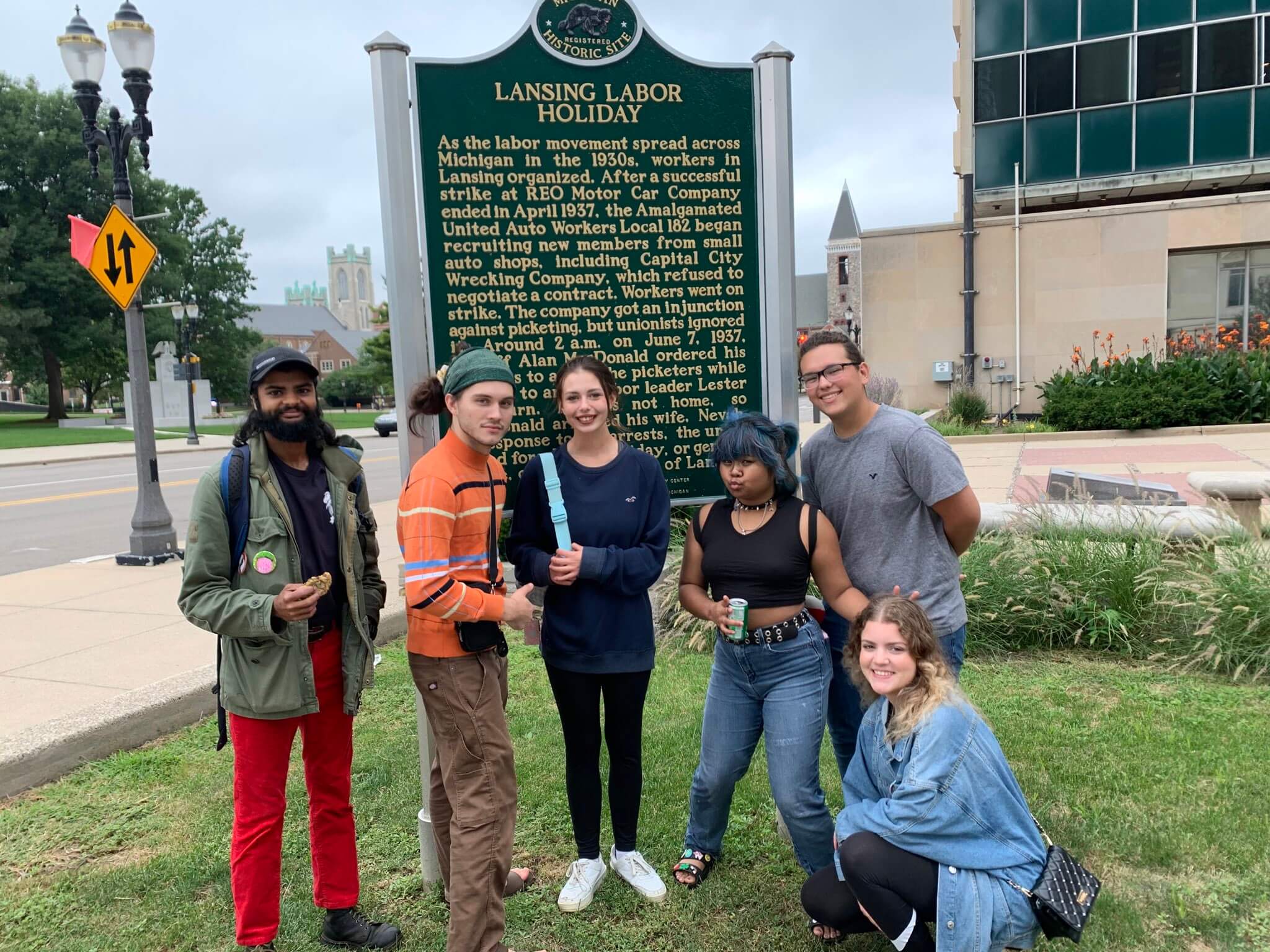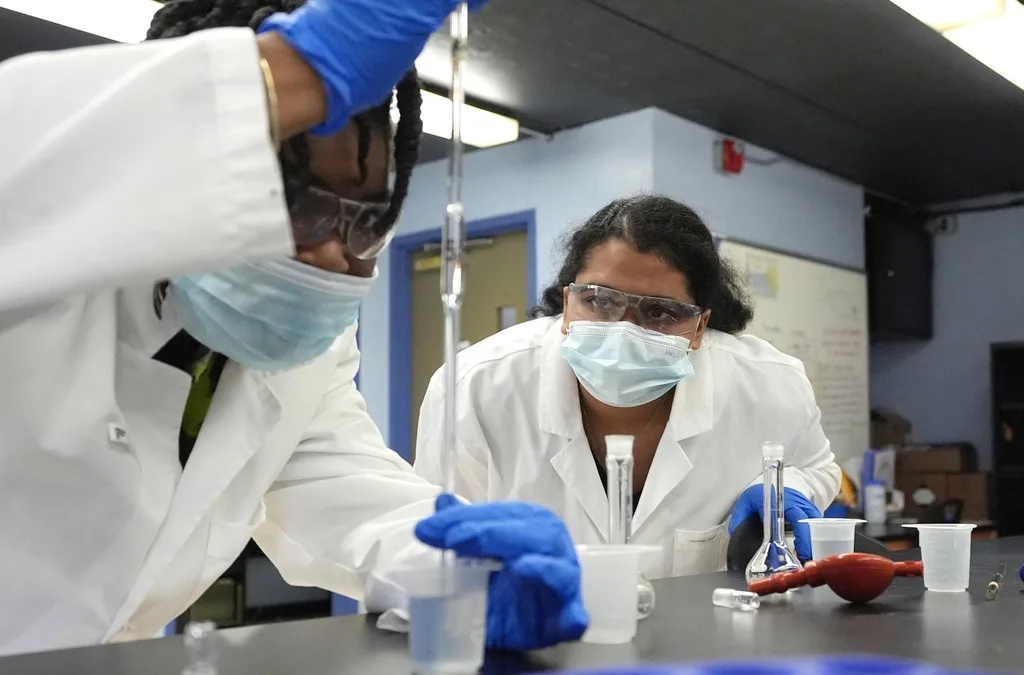
The Lansing Teamsters. Photo credit: Atulya Dora-Laskey
The first Chipotle to be unionized is here in Lansing. The organizers, with no prior union organizing experience, might not be who you’d expect.
LANSING — From a customer’s perspective, the beauty of Chipotle is consistency.
Stores in Lansing play the same music as the ones in Arizona. The same suppliers all provide the same produce and protein, which is all chopped to the same sizes. The same smells fill the air—and the meals, exactly as designed, all taste exactly the same. Everywhere.
That sameness of the Chipotle experience is tied to the exacting nature of its workforce, where each “crew member” is trained to occupy every station from grill to cashier. It’s a system designed to produce consistency and efficiency, and quickly patch gaps that might arise in the assembly line.
For workers, however, doing a little bit of everything can be strenuous—especially for those who are stuck behind the grill, often the most feared position on the line. And when someone calls off or the kitchen isn’t fully staffed, it can become downright exhausting.
When Atulya Dora-Laskey took a job at the Chipotle restaurant on the west side of Lansing, he didn’t think much about the assembly line concept. He just needed a job to help pay the rent.
Just a few months in, he said he recognized a pattern that his coworkers had caught onto as well: He was being assigned to skeleton teams that were routinely cut short by two or three crew members—despite there being plenty of people who were willing to take on shifts.
Assembly lines are cheaper to operate with fewer employees, after all. But someone has to suffer the consequences of fewer employees, and at Chipotle, that’s whoever is on the clock.
“This makes shifts quite miserable for the crew,” Dora-Laskey said.
This is the origin story of the first unionized Chipotle in the country—a group of teens and 20-somethings with minimal organizing experience who mobilized their common complaints about corporate policies into a full-steam-ahead engine of union recognition, spurred on by internet-based education, the help of local Starbucks organizers, and a change in political winds.

Some expect the movement, ignited in Lansing this summer, will spread to other Chipotle stores across the state and country, especially with a gust of renewed support for unions and upcoming political elections that could help lay the groundwork for future labor movements.
Notably polite, Dora-Laskey, 23, said he wasn’t plotting to spark a nationwide movement. He only took the job at Chipotle to move out of his parents’ place. But the working conditions there—even “the basic things”—were hard to ignore.
He cited low pay and lack of sick time during the pandemic, as well as under-scheduling, as examples.
He and other employees tried to take their concerns up the chain of command first, Dora-Laskey said. But those attempts led nowhere or, in some cases, to a reprimand.
What began as a fleeting thought—“we should have a union”—became a reality when Dora-Laskey connected with Harper McNamara, a fellow coworker-turned-organizer, during a chat about reading material outside the store.
With no formal labor connections and only a unions-for-dummies style manual, the group pulled together a compelling campaign where they ultimately won unionization by an 11-3 vote on Aug. 25, 2022, joining the Teamsters.
The victory represents the power of a bold idea, Dora-Laskey said—and of course, the necessary follow-through to turn that idea into a bold action.
The Modern Labor Movement Began in Michigan, But Things Have Changed
“This past year has all been about watching people do what (others) said couldn’t be done,” said Aliqae Geraci, the director of the Walter P. Reuther Library at Wayne State University, the continent’s largest collection of labor materials. “It’s young people without resources or experience.”
The Reuther Library contains files, artifacts, tapes, and any visual medium you can think of from across the country chronicling the labor movement. Located in Detroit, it’s based in the “mecca” of the modern-day labor movement, staff say.
Detroit, after all, is where the United Auto Workers (UAW) was founded, and where sit-down strikes were conceived. Michigan, as a whole, represented the height of the labor movement during the mid-20th century when Ford and GM, the country’s largest employers at the time, were unionized.
But from the latter half of the 20th century up until now, union support and membership have gradually eroded, assisted along by corruption within the labor organizations and a decline in support.
In 1983, 33% of Michigan workers were covered by a collective bargaining agreement; today that number is 13%, according to the Bureau of Labor Statistics.
One of the lowest points for the labor movement came after Republicans in the state Legislature passed so-called “Freedom to Work” laws that went into effect in 2013, which allow employees to be part of a union shop and reap the benefits of collective bargaining without paying membership dues or officially signing up for the union.
On the surface, due-free acceptance into unionized workplaces may sound like a good thing, but it waters down the collective strength of labor—making it easier for corporations to freewheel policies while much of the workforce isn’t paying dues to help at the negotiating table.
A healthy body of evidence suggests that when union membership is down, economic inequality is up. Falling union membership over the last five decades can be attributed to 10% of increasing inequality, a study found; in the decades before, union membership had helped reduce income inequality.
OPINION: Make Every Day a Labor Day by Giving Michigan a Pro-Worker Agenda
Even after a long road of industrial decline, Michigan ranked fifth in the US for union membership in 2012, the year before its right-to-work law came into being.
Ten years later, the birthplace of the modern labor movement isn’t even in the top 10.
“We really do feel as if there’s an increasing lack of democracy in this country and almost everywhere to a certain regard,” Dora-Laskey said. “There’s no place where that’s more clear than the workplace.”
State Rep. Terry Sabo (D-Muskegon), the chair of Michigan’s Legislative Labor Caucus, wants to see Michigan’s right-to-work laws go. He also wants to restore a high prevailing wage for building trades, whereby any contractor who takes on a government repair gig—like patching potholes—has to pay what’s considered the union rate for the work, something Democratic Gov. Gretchen Whitmer has already worked to reestablish.
In November, Sabo and Democrats may get their chance. For the first time since 1983, the Michigan Legislature could turn Democratic in the House and Senate, with the flip of seven total seats.
Paired with Whitmer, who is up for reelection, the team of Legislature and governor could reenergize Michigan’s labor base and reinvest in Michigan workers.
The labor movement and Democratic Party have historically maintained deep ties. In the two terms of Republican Gov. Rick Snyder’s administration, his side wasted no time bludgeoning organized labor, passing the right-to-work law in 2012 and repealing prevailing wage in 2018.
As Michigan writer Jarrett Skorup noted in 2020, the decline in union membership that resulted from Republican policies led to unions having less to spend to support Democratic candidates. During that time, Michigan’s income inequality gap only grew wider.
Now, Democrats want to see unions put Michigan back on the map—with Whitmer having appointed more than 200 union employees to boards, commissions, and full-time jobs.

Most people want to make sure they have a secure retirement waiting for them, and solid health care benefits, Sabo said. “That’s why I feel so strongly about labor unions and workers in general,” he said.
Support for Workers’ Rights Gains Traction Again in Michigan
The Lansing Chipotle location has received nationwide attention for being the first unionized branch of the franchise in the country. But locally, it also signals a shift in the wind: After hemorrhaging members for the better part of the last century, unions appear to be back on the rise in Michigan.
In addition to the Chipotle store in Lansing, Starbucks stores in Flint, Ann Arbor, and Lansing are among about 10 locations to also have voted in favor of unionization in the state—just four months after a Starbucks location in Grand Rapids became the first in Michigan.
Pandemic working conditions, experts have said, only highlighted a lack of sick pay and the ease at which employees could lose their jobs. Across the board, in white-collar and blue-collar jobs, support for unions has increased as a result. A national poll in August found that 71% of US residents support unions, the highest tally since 1965.
Last October, workers at Kellogg’s went on strike for three months, demanding a new contract. On Sept. 7, 2022, Eastern Michigan University faculty went on strike, seeking to have more weigh-in on their healthcare benefits. A one-day picket ultimately ended in a new contract.
“The evidence is there,” said Daniel Golodner, the American Federation of Teachers archivist at the Reuther Library. “You’re seeing how during COVID how these workers were working in these horrible conditions while still afraid.”
In 2020, the percentage of workers in unions ticked up—the reason being that union members were more likely to retain their jobs during the pandemic, according to the Bureau of Labor Statistics. But overall, the trendline has clearly pointed down, ever since “Freedom to Work.”
Now, some closely following labor trends forecast that the Lansing Chipotle could set off a spree of franchise locations that organize as well, similar to the Starbucks chain; after one Starbucks in New York unionized late last year, dozens followed suit.
“Never underestimate the power of some well-timed wins,” Geraci said.
RELATED: Updated: More Michigan Starbucks Locations Vote to Unionize
While baristas and fast food workers filing for unions is a relatively new trend nationally, unions of old are also feeling the love in Michigan.
Muskegon, the lakeside west Michigan city that Sabo represents, was in large part built by organized labor, with a CIO Hall that anchors downtown and a well-attended Labor Day parade that’s become a tradition in the city. The chapter of the UAW that resides in CIO Hall is older than the national organization even.
As employment numbers have gotten back on track, Local 113 has noticed a swell in interest too, adding members to its rolls and boasting a large turnout for Muskegon’s annual Labor Day parade.
“Things seem on the up-trend right now, both with the local and the national,” Joseph Carskadon, chief steward of UAW Local 113, said. “We feel really good about it.”
Local 113 predates the actual UAW, as it was formed three years before the union was signed. Primarily, its members work in defense engineering, building tank engines and transmissions for fighting vehicles.
Carskadon has worked at the old Teledyne and Continental plant for 21 years, without ever facing a layoff or having a fear for his job—which he credits to union strength. Now, he’s hoping to set up the pipelines so that those jobs will remain secure in Michigan. And he wants young people to fill his shoes when he retires in a few years.
“We want jobs, long secure jobs, stable companies,” Carskadon said. “Years ago, our fathers were hired into a place and retired out of it. Now, it’s not so certain anymore. … That’s what we’re looking for: the same thing for the people behind us.”
That’s what the workers at Chipotle, Starbucks, and Kellogg’s are all looking for too—the security and respect that unions had earned for workers in Michigan in years past.
Unionizing Was Their Chance to Have Power, Too
In weekly meetings, members of the Chipotle Teamsters recalled how their parents and grandparents sang the praises of unions for securing a middle-class lifestyle, health care, and a better education for their family. That image stuck with them.
Dora-Laskey said that while the scope of the movement started out as very granular—improving conditions only at the Lansing location—some workers found a larger meaning in the union.
Between the Supreme Court decision stripping abortion rights, challenges to the 2020 election, and rising income inequality, the Zoomer workforce at Chipotle has often felt pessimistic and powerless about the state of the country, Dora-Laskey said.
The union was their chance to do something about it.
“We do feel like the union was a way to restore some of that democracy,” said Dora-Laskey, “or in some ways build a democracy that never really has been.”
For as major as the movement has proven to be—even garnering a shoutout from Sen. Bernie Sanders from Vermont, a figure that Chipotle leaders have said inspired them—Dora-Laskey said he was surprised by how easy, in some ways, starting a union was.
Yes, it was still a lot of work.
Dora-Laskey read the book “Secrets to a Successful Organizer,” which laid out the steps. He cold-called dozens of unions, some who returned his calls and others who didn’t. He sourced help through the Democratic Socialists of America chapter in Lansing, to learn how people at libraries and Starbucks had done it before.
But the biggest challenge, Dora-Laskey said, was simply convincing himself and others that they could indeed organize the first Chipotle in the country.
The rest fell into place from there.
“It is pretty exciting to be the first. We always thought there would be a reason why no other Chipotle had unionized, and through this process, we thought we might find out why that is,” Dora-Laskey said. “But we never found it.”
Captured by a New Jersey professor who teaches labor relations, a video online shows the moment the National Labor Relations Board confirmed the deciding votes for the Chipotle union.
On a rainy, brisk day, the counting proceeded in a very formal, carefully monitored fashion outside of the Chipotle, organizers and interested parties on one side, government officials on the other side. As the NLRB official pulled out the deciding “yes” vote, Dora-Laskey’s stressed and focused demeanor relaxed.
He leaned over to share a hug with a fellow organizer.
“We hope that by demonstrating this is possible, we’ll make it possible for others,” Dora-Laskey said.
Victory—for now.
Some of the most important steps are still to come, like actually sitting down at the negotiating table and working out a fair contract. As Starbucks has—illegally, advocates argue—extended new benefits to all but their unionized stores, doing so may not be easy.
But in the meantime, the workers at Chipotle have already won something major at recognition. Union representatives can be present at any disciplinary meeting, and the NLRB prevents changes to the contracts of unionized workers without negotiation.
And for him, days at the store just seem better already, Dora-Laskey said, just knowing that he now has “actual” power at his place of work.
“It made the actual work of the job feel more rewarding in a way,” Dora-Laskey said. “Especially now that we have unionized, I feel like the whole atmosphere at work is different… This is our store as well.”
Politics

Biden administration bans noncompete clauses for workers
The Federal Trade Commission (FTC) voted on Tuesday to ban noncompete agreements—those pesky clauses that employers often force their workers to...

Remember Betsy? Michigan education leaders blast Trump for ‘abandoning’ public schools
Michigan lawmakers and teachers are rallying behind President Joe Biden—and reflecting on a rough period for public schools after Trump put Betsy...

Michigan Dems announce bills banning PFAS in household products
BY SUSAN J. DEMAS, MICHIGAN ADVANCE MICHIGAN—Two Democratic House members on Monday announced they are sponsoring legislation that would eventually...
Local News

Children of Flint water crisis make change as young environmental and health activists
FLINT—Their childhood memories are still vivid: warnings against drinking or cooking with tap water, enduring long lines for cases of water, washing...

These students are protecting the ‘coral reefs’ of Michigan—and you can too
Vernal pools are a critical part of Michigan’s natural ecosystem—but they’re not protected by state regulations. Here’s how Michiganders are...





